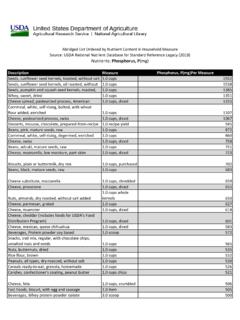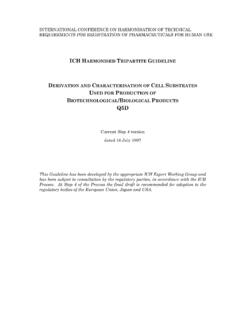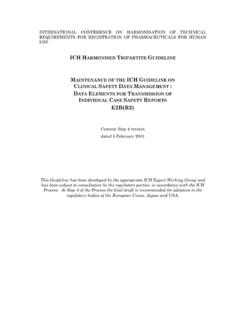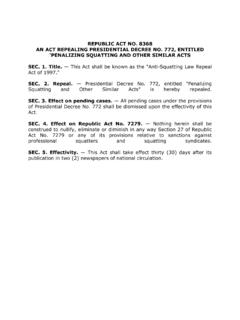Transcription of Dietary Reference Intakes (DRIs): Estimated Average ...
1 Dietary Reference Intakes (DRIs): Estimated Average Requirements Food and Nutrition Board, Institute of Medicine, National Academies Ribo- Vit Magnes- Molyb- Phos- Sele- Life Stage Calcium CHO Protein Vit A Vit C Vit D Vit E Thiamin flavin Niacin Vit B 6 Folate B 12 Copper Iodine Iron ium denum phorus nium Zinc Group (mg/d) (g/d) (g/kg/d) ( g/d)a (mg/d) ( g/d) (mg/d)b (mg/d) (mg/d) (mg/d)c (mg/d) ( g/d)d ( g/d) ( g/d) ( g/d) (mg/d) (mg/d) ( g/d) (mg/d) ( g/d) (mg/d). Infants 0 to 6 mo 6 to 12. mo Children 1 3 y 500 100 210 13 10 5 5 120 260 65 65 13 380 17 4 8 y 800 100 275 22 10 6 6 160 340 65 110 17 405 23 Males 9 13 y 1,100 100 445 39 10 9 9 250 540 73 200 26 1,055 35 14 18 y 1,100 100 630 63 10 12 12 330 685 95 340 33 1,055 45 19 30 y 800 100 625 75 10 12 12 320 700 95 6 330 34 580 45 31 50 y 800 100 625 75 10 12 12 320 700 95 6 350 34 580 45 51 70 y 800 100 625 75 10 12 12 320 700 95 6 350 34 580 45 > 70 y 1,000 100 625 75 10 12 12 320 700 95 6 350 34 580 45 Females 9 13 y 1,100 100 420 39 10 9 9 250 540 73 200 26 1,055 35 14 18 y 1,100 100 485 56 10 12 11 330 685 95 300 33 1,055 45 19 30 y 800 100 500 60 10 12 11 320 700 95 255 34 580 45 31 50 y 800 100 500 60 10 12 11 320 700 95 265 34 580 45 51 70 y 1.
2 000 100 500 60 10 12 11 320 700 95 5 265 34 580 45 > 70 y 1,000 100 500 60 10 12 11 320 700 95 5 265 34 580 45 Pregnancy 14 18 y 1,000 135 530 66 10 12 14 520 785 160 23 335 40 1,055 49 19 30 y 800 135 550 70 10 12 14 520 800 160 22 290 40 580 49 31 50 y 800 135 550 70 10 12 14 520 800 160 22 300 40 580 49 Lactation 14 18 y 1,000 160 885 96 10 16 13 450 985 209 7 300 35 1,055 59 19 30 y 800 160 900 100 10 16 13 450 1,000 209 255 36 580 59 31 50 y 800 160 900 100 10 16 13 450 1,000 209 265 36 580 59 NOTE: An Estimated Average Requirement (EAR) is the Average daily nutrient intake level Estimated to meet the requirements of half of the healthy individuals in a group. EARs have not been established for vitamin K, pantothenic acid, biotin, choline, chromium, fluoride, manganese, or other nutrients not yet evaluated via the DRI process.
3 A As retinol activity equivalents (RAEs). 1 RAE = 1 g retinol, 12 g -carotene, 24 g -carotene, or 24 g -cryptoxanthin. The RAE for Dietary provitamin A carotenoids is two-fold greater than retinol equivalents (RE), whereas the RAE for preformed vitamin A is the same as RE. b As -tocopherol. -Tocopherol includes RRR- -tocopherol, the only form of -tocopherol that occurs naturally in foods, and the 2R-stereoisomeric forms of -tocopherol (RRR-, RSR-, RRS-, and RSS- -tocopherol). that occur in fortified foods and supplements. It does not include the 2S-stereoisomeric forms of -tocopherol (SRR-, SSR-, SRS-, and SSS- -tocopherol), also found in fortified foods and supplements. c As niacin equivalents (NE). 1 mg of niacin = 60 mg of tryptophan. d As Dietary folate equivalents (DFE).
4 1 DFE = 1 g food folate = g of folic acid from fortified food or as a supplement consumed with food = g of a supplement taken on an empty stomach. SOURCES: Dietary Reference Intakes for Calcium, Phosphorous, Magnesium, Vitamin D, and Fluoride (1997); Dietary Reference Intakes for Thiamin, Riboflavin, Niacin, Vitamin B 6 , Folate, Vitamin B 12 , Pantothenic Acid, Biotin, and Choline (1998); Dietary Reference Intakes for Vitamin C, Vitamin E, Selenium, and Carotenoids (2000); Dietary Reference Intakes for Vitamin A, Vitamin K, Arsenic, Boron, Chromium, Copper, Iodine, Iron, Manganese, Molybdenum, Nickel, Silicon, Vanadium, and Zinc (2001); Dietary Reference Intakes for Energy, Carbohydrate, Fiber, Fat, Fatty Acids, Cholesterol, Protein, and Amino Acids (2002/2005); and Dietary Reference Intakes for Calcium and Vitamin D (2011).
5 These reports may be accessed via Dietary Reference Intakes (DRIs): Recommended Dietary Allowances and Adequate Intakes , Vitamins Food and Nutrition Board, Institute of Medicine, National Academies Life Stage Vitamin A Vitamin C Vitamin D Vitamin E Vitamin K Thiamin Riboflavin Niacin Vitamin B6 Folate Vitamin B12 Pantothenic Biotin Choline Group ( g/d)a (mg/d) ( g/d)b,c (mg/d) d ( g/d) (mg/d) (mg/d) (mg/d)e (mg/d) ( g/d)f ( g/d) Acid (mg/d) ( g/d) (mg/d)g Infants 0 to 6 mo 400* 40* 10 4* * * * 2* * 65* * * 5* 125*. 6 to 12 mo 500* 50* 10 5* * * * 4* * 80* * * 6* 150*. Children 1 3 y 300 15 15 6 30* 6 150 2* 8* 200*. 4 8 y 400 25 15 7 55* 8 200 3* 12* 250*. Males 9 13 y 600 45 15 11 60* 12 300 4* 20* 375*. 14 18 y 900 75 15 15 75* 16 400 5* 25* 550*. 19 30 y 900 90 15 15 120* 16 400 5* 30* 550*.
6 31 50 y 900 90 15 15 120* 16 400 5* 30* 550*. 51 70 y 900 90 15 15 120* 16 400 5* 30* 550*. h > 70 y 900 90 20 15 120* 16 400 5* 30* 550*. Females 9 13 y 600 45 15 11 60* 12 300 4* 20* 375*. 14 18 y 700 65 15 15 75* 14 400i 5* 25* 400*. 19 30 y 700 75 15 15 90* 14 400i 5* 30* 425*. 31 50 y 700 75 15 15 90* 14 400i 5* 30* 425*. h 51 70 y 700 75 15 15 90* 14 400 5* 30* 425*. > 70 y 700 75 20 15 90* 14 400 5* 30* 425*. Pregnancy 14 18 y 750 80 15 15 75* 18 600j 6* 30* 450*. 19 30 y 770 85 15 15 90* 18 600j 6* 30* 450*. 31 50 y 770 85 15 15 90* 18 600j 6* 30* 450*. Lactation 14 18 y 1,200 115 15 19 75* 17 500 7* 35* 550*. 19 30 y 1,300 120 15 19 90* 17 500 7* 35* 550*. 31 50 y 1,300 120 15 19 90* 17 500 7* 35* 550*. NOTE: This table (taken from the DRI reports, see ) presents Recommended Dietary Allowances (RDAs) in bold type and Adequate Intakes (AIs) in ordinary type followed by an asterisk (*).
7 An RDA is the Average daily Dietary intake level; sufficient to meet the nutrient requirements of nearly all (97-98 percent) healthy individuals in a group. It is calculated from an Estimated Average Requirement (EAR). If sufficient scientific evidence is not available to establish an EAR, and thus calculate an RDA, an AI is usually developed. For healthy breastfed infants, an AI is the mean intake. The AI for other life stage and gender groups is believed to cover the needs of all healthy individuals in the groups, but lack of data or uncertainty in the data prevent being able to specify with confidence the percentage of individuals covered by this intake. a As retinol activity equivalents (RAEs). 1 RAE = 1 g retinol, 12 g -carotene, 24 g -carotene, or 24 g -cryptoxanthin.
8 The RAE for Dietary provitamin A carotenoids is two-fold greater than retinol equivalents (RE), whereas the RAE for preformed vitamin A is the same as RE. b As cholecalciferol. 1 g cholecalciferol = 40 IU vitamin D. c Under the assumption of minimal sunlight. d As -tocopherol. -Tocopherol includes RRR- -tocopherol, the only form of -tocopherol that occurs naturally in foods, and the 2R-stereoisomeric forms of -tocopherol (RRR-, RSR-, RRS-, and RSS- -tocopherol) that occur in fortified foods and supplements. It does not include the 2S-stereoisomeric forms of -tocopherol (SRR-, SSR-, SRS-, and SSS- -tocopherol), also found in fortified foods and supplements. e As niacin equivalents (NE). 1 mg of niacin = 60 mg of tryptophan; 0 6 months = preformed niacin (not NE).
9 F As Dietary folate equivalents (DFE). 1 DFE = 1 g food folate = g of folic acid from fortified food or as a supplement consumed with food = g of a supplement taken on an empty stomach. g Although AIs have been set for choline, there are few data to assess whether a Dietary supply of choline is needed at all stages of the life cycle, and it may be that the choline requirement can be met by endogenous synthesis at some of these stages. h Because 10 to 30 percent of older people may malabsorb food-bound B12, it is advisable for those older than 50 years to meet their RDA mainly by consuming foods fortified with B12 or a supplement containing B12. i In view of evidence linking folate intake with neural tube defects in the fetus, it is recommended that all women capable of becoming pregnant consume 400 g from supplements or fortified foods in addition to intake of food folate from a varied diet.
10 J It is assumed that women will continue consuming 400 g from supplements or fortified food until their pregnancy is confirmed and they enter prenatal care, which ordinarily occurs after the end of the periconceptional period the critical time for formation of the neural tube. SOURCES: Dietary Reference Intakes for Calcium, Phosphorous, Magnesium, Vitamin D, and Fluoride (1997); Dietary Reference Intakes for Thiamin, Riboflavin, Niacin, Vitamin B6, Folate, Vitamin B12, Pantothenic Acid, Biotin, and Choline (1998); Dietary Reference Intakes for Vitamin C, Vitamin E, Selenium, and Carotenoids (2000); Dietary Reference Intakes for Vitamin A, Vitamin K, Arsenic, Boron, Chromium, Copper, Iodine, Iron, Manganese, Molybdenum, Nickel, Silicon, Vanadium, and Zinc (2001); Dietary Reference Intakes for Water, Potassium, Sodium, Chloride, and Sulfate (2005); and Dietary Reference Intakes for Calcium and Vitamin D (2011).












